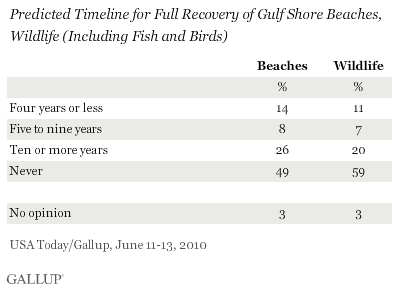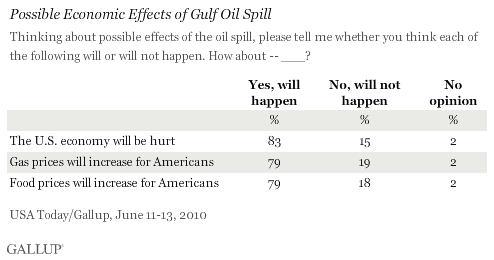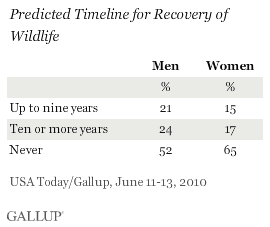PRINCETON, NJ -- From what they have seen of the Gulf of Mexico oil spill rolling onto America's shores, nearly half of Americans (49%) believe that at least some of the affected beaches will never recover. Even more, 59%, believe normal levels for some animal species will never be restored.

More generally, Americans foresee a very long road to recovery for both the U.S. beaches and wildlife affected by the BP oil spill. The vast majority believe it will be a decade or more, if at all, before either aspect of the Gulf environment is back to normal; few think a full recovery will happen within four years.
Separately, Americans broadly agree that the oil spill will negatively affect the U.S. economy and the U.S. consumer. Roughly four in five believe the overall U.S. economy will be hurt, that gas prices will go up, and that food prices will increase.

Women More Pessimistic Than Men About Undoing Oil Damage
The most striking subgroup differences in views about the oil spill's impact are by gender, with women much more pessimistic than men. (Gallup has previously found women to be more concerned than men about environmental matters.)
Sixty percent of women, compared with 37% of men, believe some Gulf beaches will never recover -- a 23 percentage-point gap. Additionally, there is a 13-point gap between men's and women's perceptions of whether the affected wildlife will fully recover.


Women are also more likely than men to believe that gas prices will increase (83% vs. 74%), and that the U.S. economy in general will be hurt (88% vs. 78%).
Bottom Line
In his remarks when visiting the Gulf shoreline this week, as well as in his Oval Office address Tuesday night, President Obama has stressed the need for a long-term commitment to the oil spill cleanup. Americans may be getting impatient with BP and the federal government for not doing enough to cap the gushing oil rig and contain the leaked oil, but it appears they are resigned to a lengthy process to restore the beaches and wildlife, with perhaps limited success.
Survey Methods
Results for this USA Today/Gallup poll are based on telephone interviews conducted June 11-13, 2010, with a random sample of 1,014 adults, aged 18 and older, living in the continental U.S., selected using random-digit-dial sampling.
For results based on the total sample of national adults, one can say with 95% confidence that the maximum margin of sampling error is ±4 percentage points.
Interviews are conducted with respondents on landline telephones (for respondents with a landline telephone) and cellular phones (for respondents who are cell phone-only). Each sample includes a minimum quota of 150 cell phone-only respondents and 850 landline respondents, with additional minimum quotas among landline respondents for gender within region. Landline respondents are chosen at random within each household on the basis of which member had the most recent birthday.
Samples are weighted by gender, age, race, education, region, and phone lines. Demographic weighting targets are based on the March 2009 Current Population Survey figures for the aged 18 and older non-institutionalized population living in continental U.S. telephone households. All reported margins of sampling error include the computed design effects for weighting and sample design.
In addition to sampling error, question wording and practical difficulties in conducting surveys can introduce error or bias into the findings of public opinion polls.
View methodology, full question results, and trend data.
For more details on Gallup's polling methodology, visit https://www.gallup.com/.
